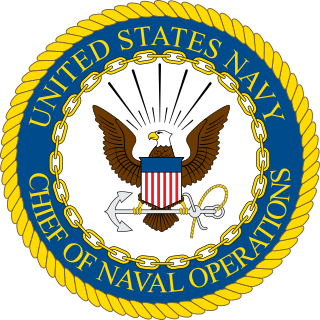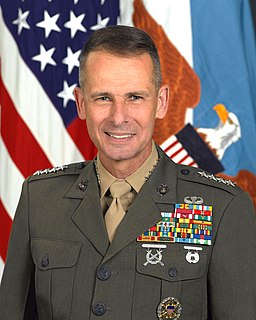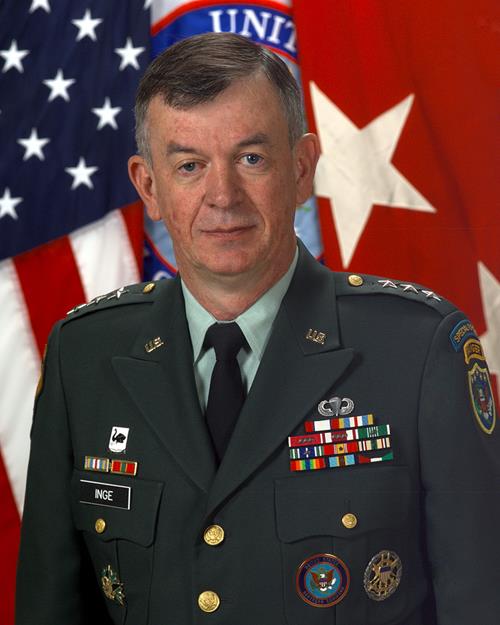
The Chief of Naval Operations (CNO) is the head of the United States Navy. The position is a statutory office held by a four-star admiral who is a military adviser and deputy to the Secretary of the Navy. In a separate capacity as a member of the Joint Chiefs of Staff the CNO is a military adviser to the National Security Council, the Homeland Security Council, the Secretary of Defense, and the President. The current Chief of Naval Operations is Admiral Michael M. Gilday.

The Chairman of the Joint Chiefs of Staff (CJCS) is, by U.S. law, the highest-ranking and senior-most military officer in the United States Armed Forces and is the principal military advisor to the President, the National Security Council, the Homeland Security Council, and the Secretary of Defense. While the Chairman of the Joint Chiefs of Staff outranks all other commissioned officers, the Chairman is prohibited by law from having operational command authority over the armed forces; however, the Chairman does assist the President and the Secretary of Defense in exercising their command functions.

Peter Pace is a United States Marine Corps general who served as the 16th Chairman of the Joint Chiefs of Staff. Pace was the first Marine officer appointed as chairman, and the first Marine officer to be appointed to three different four-star assignments; the others as the 6th Vice Chairman of the Joint Chiefs of Staff from October 1, 2001, to August 12, 2005, and as Commander-in-Chief, U.S. Southern Command from September 8, 2000, to September 30, 2001. Appointed chairman by President George W. Bush, Pace succeeded U.S. Air Force General Richard Myers on September 30, 2005.

The Chief of Staff of the Army (CSA) is a statutory office held by a four-star general in the United States Army. As the most senior uniformed officer assigned to serve in the Department of the Army, the CSA is the principal military advisor and a deputy to the Secretary of the Army. In a separate capacity, the CSA is a member of the Joint Chiefs of Staff and, thereby, a military advisor to the National Security Council, the Secretary of Defense, and the President of the United States. The CSA is typically the highest-ranking officer on active-duty in the U.S. Army unless the Chairman or the Vice Chairman of the Joint Chiefs of Staff are Army officers.

The Goldwater–Nichols Department of Defense Reorganization Act of October 4, 1986 Pub.L. 99–433,, made the most sweeping changes to the United States Department of Defense since the department was established in the National Security Act of 1947 by reworking the command structure of the United States military. It increased the powers of the chairman of the Joint Chiefs of Staff and implemented some of the suggestions from the Packard Commission, commissioned by President Reagan in 1985. Among other changes, Goldwater–Nichols streamlined the military chain of command, which now runs from the president through the secretary of defense directly to combatant commanders, bypassing the service chiefs. The service chiefs were assigned to an advisory role to the president and the secretary of defense as well as given the responsibility for training and equipping personnel for the unified combatant commands.

Edmund P. Giambastiani Jr. is a retired United States Navy admiral who served as the seventh Vice Chairman of the Joint Chiefs of Staff from 2005 to 2007. He retired in 2007, after 37 years of service.

The Chief of Staff of the Air Force is a statutory office held by a four-star general in the United States Air Force, and is the most senior uniformed officer assigned to serve in the Department of the Air Force, and as such is the principal military advisor and a deputy to the Secretary of the Air Force; and is in a separate capacity a member of the Joint Chiefs of Staff, and thereby a military adviser to the National Security Council, the Secretary of Defense, and the President. The Chief of Staff is typically the highest-ranking officer on active duty in the Air Force unless the Chairman and/or the Vice Chairman of the Joint Chiefs of Staff are Air Force officers.

The Recruiter Badge is a decoration of the United States uniformed services that is awarded to personnel who have performed recruitment duties as service recruiters. The Recruiter Badge is issued by every branch of the U.S. uniform services except for the U.S. Marine Corps and the NOAA Commissioned Corps. With the exception of the U.S. Army, a Recruiting Service Ribbon is also awarded to those personnel who have completed successful tours as uniform service recruiters.

Identification badges of the Uniformed Services of the United States are insignia worn by service members conducting special duties, many of which can be awarded as permanent decorations if those duties are performed successfully. There are a few identification badges that are awarded to all services, others are specific to a uniform service. The Office of the President and Vice President and department/service headquarters badges are permanent decorations for those who successfully serve in those assignments. Some of the service level identification badges can be permanent decorations and others are only worn by a service member while performing specific duties, such as the Military Police Badge.

Insignias and badges of the United States Navy are military "badges" issued by the United States Department of the Navy to naval service members who achieve certain qualifications and accomplishments while serving on both active and reserve duty in the United States Navy. Most naval aviation insignia are also permitted for wear on uniforms of the United States Marine Corps.

Harry Edward Soyster is a retired United States Army Lieutenant General.

Branch insignia of the United States Army refers to military emblems that may be worn on the uniform of the United States Army to denote membership in a particular area of expertise and series of functional areas. Army branch insignia is similar to the line officer and staff corps officer devices of the U.S. Navy as well as to the Navy enlisted rating badges. The Medical, Nurse, Dental, Veterinary, Medical Service, Medical Specialist, Chaplains, and Judge Advocate General's Corps are considered "special branches", while the others are "basic branches".

Lieutenant General Franklin L. Hagenbeck is a retired United States Army officer who served as the 57th Superintendent of the United States Military Academy, West Point, New York, from June 2006 to July 2010. Previous to his assignment at West Point, he was the Deputy Chief of Staff, G-1 United States Army, Washington, D.C.

Lieutenant General Robert T. Clark is a retired United States Army officer.

Lieutenant General Joseph R. Inge concluded a 38-year career as an army officer as Deputy Commander, United States Northern Command, and Vice Commander, U.S. Element, North American Aerospace Defense Command (USELEMNORAD), headquartered at Peterson Air Force Base, Colorado in 2007.

Richard Hastings Ellis was a United States Air Force general who served as the commander in chief of the Strategic Air Command and director of the Joint Strategic Target Planning Staff with headquarters at Offutt Air Force Base, Nebraska. He was also director of the Joint Strategic Connectivity Staff.

Douglas Edward Lute is a U.S. public servant who served as the United States Permanent Representative to NATO from 2013 to 2017. He was nominated for the post by President Obama on May 23, 2013, and assumed his position on September 3, 2013.

John Harold Tilelli Jr. is a retired United States Army four-star general who served as Vice Chief of Staff of the U.S. Army (VCSA) from 1994 to 1995; Commanding General, U.S. Army Forces Command from 1995 to 1996; and Commander in Chief, United Nations Command/Commander in Chief, ROK/U.S. Combined Forces Command/Commander, U.S. Forces Korea (CINCUNC/CINCCFC/COMUSFK) from 1996 to 1999. He retired from the U.S. Army on January 31, 2000 and later worked for the USO and The Aerospace Corporation.

Major General Thomas E. Ayres is a retired American military lawyer who served as the 20th Deputy Judge Advocate General of the United States Army. On January 18, 2018, President Donald Trump nominated him to become General Counsel of the Department of the Air Force. This nomination was confirmed by the U.S. Senate on February 15, 2018.





















